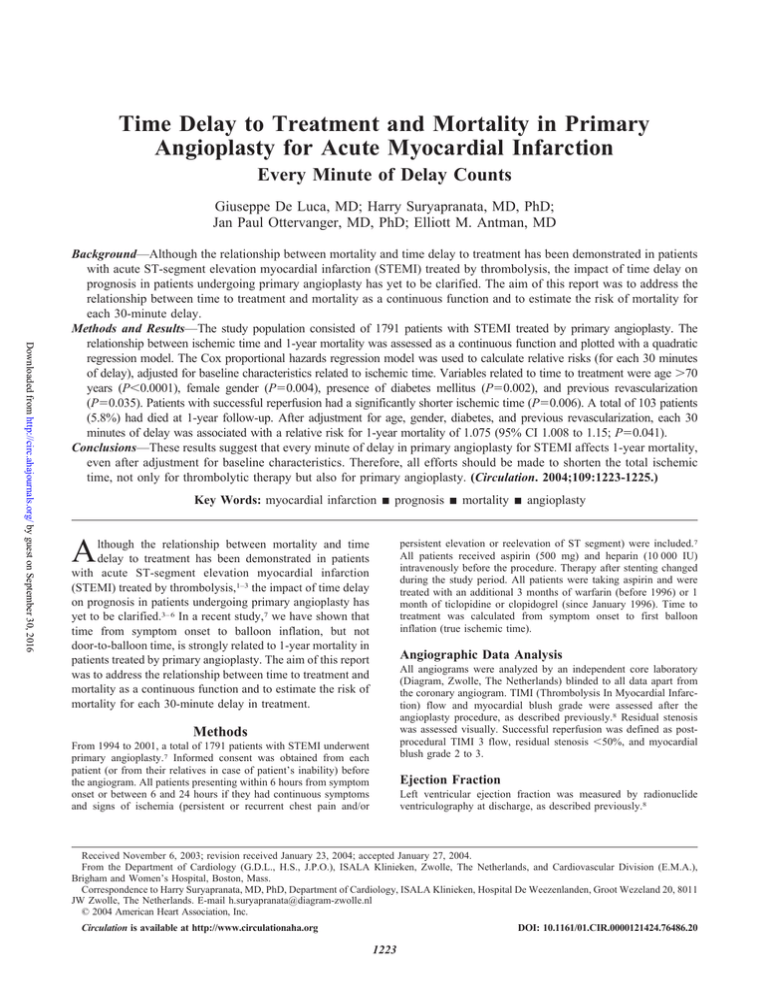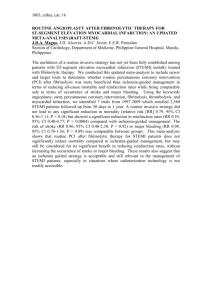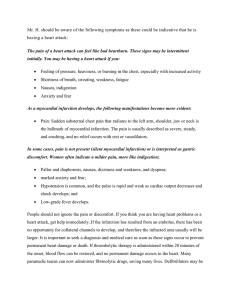
Time Delay to Treatment and Mortality in Primary
Angioplasty for Acute Myocardial Infarction
Every Minute of Delay Counts
Giuseppe De Luca, MD; Harry Suryapranata, MD, PhD;
Jan Paul Ottervanger, MD, PhD; Elliott M. Antman, MD
Downloaded from http://circ.ahajournals.org/ by guest on September 30, 2016
Background—Although the relationship between mortality and time delay to treatment has been demonstrated in patients
with acute ST-segment elevation myocardial infarction (STEMI) treated by thrombolysis, the impact of time delay on
prognosis in patients undergoing primary angioplasty has yet to be clarified. The aim of this report was to address the
relationship between time to treatment and mortality as a continuous function and to estimate the risk of mortality for
each 30-minute delay.
Methods and Results—The study population consisted of 1791 patients with STEMI treated by primary angioplasty. The
relationship between ischemic time and 1-year mortality was assessed as a continuous function and plotted with a quadratic
regression model. The Cox proportional hazards regression model was used to calculate relative risks (for each 30 minutes
of delay), adjusted for baseline characteristics related to ischemic time. Variables related to time to treatment were age ⬎70
years (P⬍0.0001), female gender (P⫽0.004), presence of diabetes mellitus (P⫽0.002), and previous revascularization
(P⫽0.035). Patients with successful reperfusion had a significantly shorter ischemic time (P⫽0.006). A total of 103 patients
(5.8%) had died at 1-year follow-up. After adjustment for age, gender, diabetes, and previous revascularization, each 30
minutes of delay was associated with a relative risk for 1-year mortality of 1.075 (95% CI 1.008 to 1.15; P⫽0.041).
Conclusions—These results suggest that every minute of delay in primary angioplasty for STEMI affects 1-year mortality,
even after adjustment for baseline characteristics. Therefore, all efforts should be made to shorten the total ischemic
time, not only for thrombolytic therapy but also for primary angioplasty. (Circulation. 2004;109:1223-1225.)
Key Words: myocardial infarction 䡲 prognosis 䡲 mortality 䡲 angioplasty
A
lthough the relationship between mortality and time
delay to treatment has been demonstrated in patients
with acute ST-segment elevation myocardial infarction
(STEMI) treated by thrombolysis,1–3 the impact of time delay
on prognosis in patients undergoing primary angioplasty has
yet to be clarified.3– 6 In a recent study,7 we have shown that
time from symptom onset to balloon inflation, but not
door-to-balloon time, is strongly related to 1-year mortality in
patients treated by primary angioplasty. The aim of this report
was to address the relationship between time to treatment and
mortality as a continuous function and to estimate the risk of
mortality for each 30-minute delay in treatment.
persistent elevation or reelevation of ST segment) were included.7
All patients received aspirin (500 mg) and heparin (10 000 IU)
intravenously before the procedure. Therapy after stenting changed
during the study period. All patients were taking aspirin and were
treated with an additional 3 months of warfarin (before 1996) or 1
month of ticlopidine or clopidogrel (since January 1996). Time to
treatment was calculated from symptom onset to first balloon
inflation (true ischemic time).
Angiographic Data Analysis
All angiograms were analyzed by an independent core laboratory
(Diagram, Zwolle, The Netherlands) blinded to all data apart from
the coronary angiogram. TIMI (Thrombolysis In Myocardial Infarction) flow and myocardial blush grade were assessed after the
angioplasty procedure, as described previously.8 Residual stenosis
was assessed visually. Successful reperfusion was defined as postprocedural TIMI 3 flow, residual stenosis ⬍50%, and myocardial
blush grade 2 to 3.
Methods
From 1994 to 2001, a total of 1791 patients with STEMI underwent
primary angioplasty.7 Informed consent was obtained from each
patient (or from their relatives in case of patient’s inability) before
the angiogram. All patients presenting within 6 hours from symptom
onset or between 6 and 24 hours if they had continuous symptoms
and signs of ischemia (persistent or recurrent chest pain and/or
Ejection Fraction
Left ventricular ejection fraction was measured by radionuclide
ventriculography at discharge, as described previously.8
Received November 6, 2003; revision received January 23, 2004; accepted January 27, 2004.
From the Department of Cardiology (G.D.L., H.S., J.P.O.), ISALA Klinieken, Zwolle, The Netherlands, and Cardiovascular Division (E.M.A.),
Brigham and Women’s Hospital, Boston, Mass.
Correspondence to Harry Suryapranata, MD, PhD, Department of Cardiology, ISALA Klinieken, Hospital De Weezenlanden, Groot Wezeland 20, 8011
JW Zwolle, The Netherlands. E-mail h.suryapranata@diagram-zwolle.nl
© 2004 American Heart Association, Inc.
Circulation is available at http://www.circulationaha.org
DOI: 10.1161/01.CIR.0000121424.76486.20
1223
1224
Circulation
March 16, 2004
Patient Characteristics and Ischemic Time
Variable
Downloaded from http://circ.ahajournals.org/ by guest on September 30, 2016
Yes
No
P
Age ⬎70 y
237⫾149
208⫾139
⬍0.0001
Female gender
233⫾137
208⫾139
0.004
Diabetes
248⫾195
211⫾135
0.002
Previous CABG/PCI
217⫾146
190⫾68
0.035
Previous infarction
202⫾76
216⫾148
NS
Hypertension
203⫾70
218⫾156
NS
Hypercholesterolemia
205⫾121
217⫾146
NS
Smoking
212⫾124
217⫾155
NS
Killip class ⬎1
214⫾123
214⫾144
NS
Anterior infarction
215⫾148
213⫾135
NS
TIMI flow 0–1 preprocedure
214⫾128
215⫾174
NS
Multivessel disease
213⫾112
215⫾169
NS
Successful reperfusion*
208⫾120
229⫾188
0.006
Stent
211⫾119
217⫾161
NS
EF ⬍30%†
237⫾138
214⫾140
0.04
CABG indicates coronary artery bypass graft; PCI, percutaneous coronary
intervention; EF, ejection fraction at discharge.
*Defined as postprocedural TIMI 3 flow, residual restenosis ⬍50%, and
myocardial blush grade 2 to 3.
†Ejection fraction at discharge was available in 1143 patients.
Clinical Outcome
Records of all patients who visited our outpatient clinic were
reviewed. For all other patients, information was obtained from the
patient’s general physician or by direct telephone interview with the
patient. For patients who died during follow-up, hospital records and
necropsy data were reviewed. No patient was lost to follow-up.
Statistical Analysis
Statistical analysis was performed with the SPSS 10.0 statistical
package. Continuous data were expressed as mean⫾SD and categorical data as percentage. ANOVA and 2 test were used appropriately
for continuous and categorical variables, respectively. A logistic
regression analysis was used to evaluate the relationship between
time to treatment and predischarge ejection fraction, after adjustment
for baseline characteristics related to ischemic time. The relationship
between ischemic time and 1-year mortality was assessed as a
continuous function and plotted with a quadratic regression model.
Cox proportional hazards regression model was used to calculate
relative risks (for each 30-minute delay), adjusted for baseline
characteristics related to ischemic time.
Results
Time to treatment according to patients’ demographic, clinical, and angiographic characteristics is reported in the Table.
Variables significantly related to time to treatment were age
⬎70 years (237⫾149 versus 208⫾139 minutes, P⬍0.0001),
female gender (233⫾137 versus 208⫾139 minutes,
P⫽0.004), diabetes (248⫾195 versus 211⫾135 minutes,
P⫽0.002), and previous revascularization (217⫾146 versus
190⫾68 minutes, P⫽0.035). When analyzed as a continuous
variable, age was linearly related to ischemic time (r⫽0.096,
P⬍0.0001). Ischemic time was inversely associated with
predischarge ejection fraction (r⫽⫺0.068, P⫽0.022). After
adjustment for age (as a continuous variable), gender, diabetes, and previous revascularization, each 30-minute delay was
associated with an OR of predischarge ejection fraction
⬍30% of 1.087 (95% CI 1.023 to 1.15; P⫽0.005). Patients
Relationship between time to treatment and 1-year mortality, as
continuous function, was assessed with quadratic regression
model. Dotted lines represent 95% CIs of predicted mortality.
with successful reperfusion had a significantly shorter ischemic time (208⫾120 versus 229⫾188 minutes, P⫽0.006).
A total of 103 patients (5.8%) had died at 1-year follow-up.
The relationship between time to treatment and mortality is
depicted in the Figure. After adjustment for age (as a continuous
variable), gender, diabetes, and previous revascularization, each
30-minute delay was associated with a relative risk of 1-year
mortality of 1.075 (95% CI 1.008 to 1.15; P⫽0.041).
Discussion
The major finding of the present study is that every minute of
delay in treatment of patients with STEMI does affect 1-year
mortality, not only in thrombolytic therapy but also in
primary angioplasty. In fact, the risk of 1-year mortality is
increased by 7.5% for each 30-minute delay.
Despite the demonstrated prognostic role of time delay to
treatment in patients with STEMI treated by thrombolysis,1–3 its
role in patients treated with primary angioplasty remains controversial.3–7 In a pooled analysis of all randomized trials that
compared thrombolysis and primary angioplasty, Zijlstra et al3
found that mortality linearly increased with time delay only in
patients treated by thrombolysis, whereas it was relatively stable
in patients treated by primary angioplasty. Cannon et al,4 in a
cohort of 27 080 patients undergoing primary angioplasty, found
that only door-to-balloon time and not symptom onset–toballoon time was associated with mortality. The absence of any
relationship between ischemic time and mortality in primary
angioplasty may be related to the potential low-risk profile of
patients enrolled in randomized trials.3 In fact, as reported by
Antoniucci et al,5 symptom onset–to-balloon time was associated with higher mortality, particularly in high-risk patients.
These data have been strongly supported by recent reports.6,7 A
major limitation of the study by Cannon et al4 is that very long
door-to-balloon time (⬎2 hours) was observed in up to 50% of
patients, which may affect the relationship between time delay
and mortality. This confounding mechanism does not play a
major role in single-center studies. In our previous report,7
symptom onset–to-balloon time (true ischemic time) and not
door-to-balloon time was a predictor of 1-year mortality.
A major explanation for our findings is that as demonstrated in animal models,9 –11 infarct size is significantly
affected by the duration of coronary occlusion. Therefore,
De Luca et al
Ischemic Time and Mortality in Primary Angioplasty
Downloaded from http://circ.ahajournals.org/ by guest on September 30, 2016
late reperfusion is expected to result in less myocardial
salvage and a higher mortality rate than found with early
reperfusion, even when optimal mechanical reperfusion is
applied. In support of these data, Stone et al12 found preprocedural TIMI-3 flow to be an independent predictor of
mortality. Furthermore, a delay in reperfusion may be associated with an older, organized intracoronary thrombus compared with an early reperfusion. This may result in a higher
incidence of distal embolization with lower postprocedural
TIMI-3 flow and poor myocardial perfusion.8 In fact, we
found that patients with successful reperfusion (postprocedural TIMI-3 flow with residual stenosis ⬍50% and optimal
myocardial perfusion [myocardial blush grade 2 to 3]) had a
significantly shorter ischemic time.
Because of the time dependence of thrombolytic therapy in
obtaining optimal restoration of epicardial flow, time delay to
treatment would be expected to increase the relative risk of
mortality more remarkably when thrombolysis is administered
than when mechanical reperfusion is used. Although primary
angioplasty, in comparison with thrombolysis, may guarantee a
higher rate of reperfusion in patients presenting late, it cannot
prevent myocardial necrosis, which is related to the duration of
occlusion, particularly in higher-risk patients.5–7
Conclusions
The results of this study strongly support the prognostic
implication of time delay in patients with STEMI undergoing
primary angioplasty. Therefore, all efforts should be made to
shorten total ischemic time, not only for thrombolytic therapy
but also for primary angioplasty.
References
1. Fibrinolytic Therapy Trialists’ (FTT) Collaborative Group. Indications
for fibrinolytic therapy and suspected acute myocardial infarction: col-
2.
3.
4.
5.
6.
7.
8.
9.
10.
11.
12.
1225
laborative overview of early mortality and major morbidity results from
all randomised trials of more than 1000 patients. Lancet. 1994;343:
311–322.
Newby LK, Rutsch WR, Califf RM, et al. Time from symptom onset to
treatment and outcomes after thrombolytic therapy. J Am Coll Cardiol.
1996;27:1646 –1655.
Zijlstra F, Patel A, Jones M, et al. Clinical characteristics and outcome of
patients with early (⬍2h), intermediate (2– 4h) and late (⬎4h) presentation treated by primary coronary angioplasty or thrombolytic therapy for
acute myocardial infarction. Eur Heart J. 2002;23:550 –557.
Cannon GP, Gibson GM, Lambrew CT, et al. Relationship of symptomonset-to-balloon time and door-to-balloon time with mortality in patients
undergoing angioplasty for acute myocardial infarction. JAMA. 2000;283:
2941–2947.
Antoniucci D, Valenti R, Migliorini A, et al. Relation of time to
treatment and mortality in patients with acute myocardial infarction
undergoing primary coronary angioplasty. Am J Cardiol. 2002;89:
1248 –1252.
Brodie BR, Stuckey TD, Muncy DB, et al. Importance of time-toreperfusion in patients with acute myocardial infarction with and without
cardiogenic shock treated with primary percutaneous coronary intervention. Am Heart J. 2003;145:708 –715.
De Luca G, Suryapranata H, Zijlstra F, et al. Symptom-onset-to-balloon
time and mortality in patients with acute myocardial infarction treated by
primary angioplasty. J Am Coll Cardiol. 2003;42:991–997.
Henriques JP, Zijlstra F, Ottervanger JP, et al. Incidence and clinical
significance of distal embolization during primary angioplasty for acute
myocardial infarction. Eur Heart J. 2002;23:1112–1117.
Flameng W, Lesaffre E, Vanhaecke J. Determinants of infarct size in
non-human primates. Basic Res Cardiol. 1990;85:392– 403.
Reimer KA, Vander Heide RS, Richard VJ, et al. Reperfusion in acute
myocardial infarction: effects of timing and modulating factors in experimental models. Am J Cardiol. 1993;72:13G–21G.
Dorado DG, Theroux P, Elizaga J, et al. Myocardial infarction in the pig
heart model: infarct size and duration of coronary occlusion. Cardiovasc
Res. 1987;21:537–544.
Stone GW, Cox D, Garcia E, et al. Normal flow (TIMI-3) before
mechanical reperfusion therapy is an independent determinant of survival
in acute myocardial infarction: analysis from the primary angioplasty in
myocardial infarction trials. Circulation. 2001;104:624 – 626.
Time Delay to Treatment and Mortality in Primary Angioplasty for Acute Myocardial
Infarction: Every Minute of Delay Counts
Giuseppe De Luca, Harry Suryapranata, Jan Paul Ottervanger and Elliott M. Antman
Downloaded from http://circ.ahajournals.org/ by guest on September 30, 2016
Circulation. 2004;109:1223-1225; originally published online March 8, 2004;
doi: 10.1161/01.CIR.0000121424.76486.20
Circulation is published by the American Heart Association, 7272 Greenville Avenue, Dallas, TX 75231
Copyright © 2004 American Heart Association, Inc. All rights reserved.
Print ISSN: 0009-7322. Online ISSN: 1524-4539
The online version of this article, along with updated information and services, is located on the
World Wide Web at:
http://circ.ahajournals.org/content/109/10/1223
Permissions: Requests for permissions to reproduce figures, tables, or portions of articles originally published
in Circulation can be obtained via RightsLink, a service of the Copyright Clearance Center, not the Editorial
Office. Once the online version of the published article for which permission is being requested is located,
click Request Permissions in the middle column of the Web page under Services. Further information about
this process is available in the Permissions and Rights Question and Answer document.
Reprints: Information about reprints can be found online at:
http://www.lww.com/reprints
Subscriptions: Information about subscribing to Circulation is online at:
http://circ.ahajournals.org//subscriptions/



